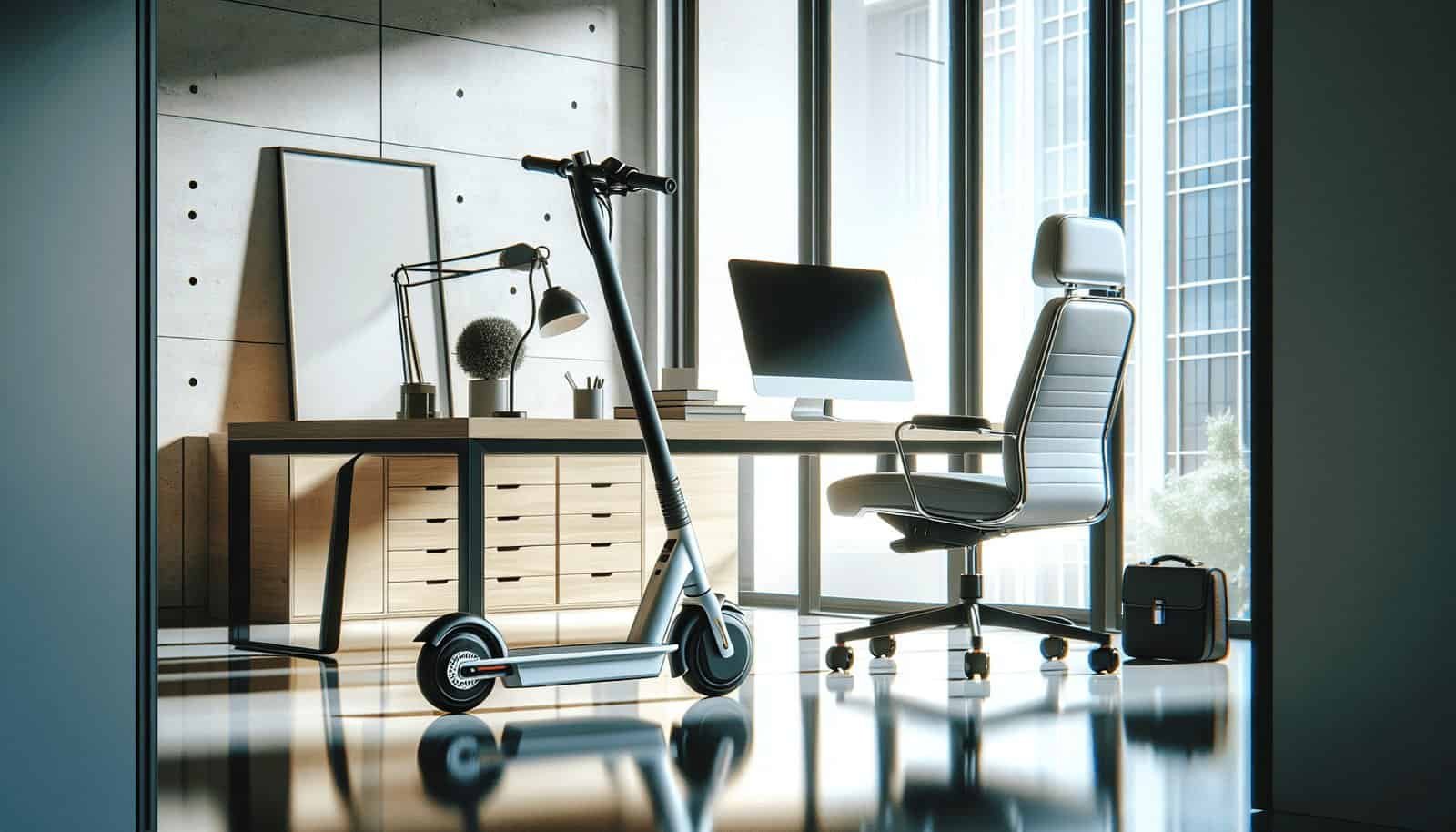Thinking about spicing up your daily commute with a bit of fun and convenience? “Can I Use An Electric Scooter For Commuting To Work And Storing It At The Office?” dives into the ins and outs of using an electric scooter for your everyday journey to work and what it takes to store it safely once you arrive. You’ll explore the benefits, practical considerations, and essential tips to make your scooter commute smooth and hassle-free. Spoiler alert: It’s surprisingly easy and might just revolutionize the way you think about getting to the office.
Can I Use An Electric Scooter For Commuting To Work And Storing It At The Office?
Have you ever found yourself stuck in traffic on your daily commute, gazing at the clock and wishing there was a better way? Or perhaps you’ve looked at the rising costs of public transportation and thought, “There has to be a more efficient way to get to work.” If these thoughts have crossed your mind, you’re certainly not alone. It seems like the perfect time to explore the idea of using an electric scooter for commuting to work and storing it at the office.
The Rise of Electric Scooters
Electric scooters have surged in popularity over the last few years. They offer a convenient, eco-friendly, and often cost-effective alternative to more traditional methods of getting around. But are they really a viable option for your daily commute to work?
What is an Electric Scooter?
An electric scooter is a two-wheeled motorized vehicle that operates on an electric battery. It’s compact, lightweight, and designed for easy navigation through city streets. The scooters are equipped with a stand-on platform where you can stand while riding. Modern electric scooters come with a variety of features, including adjustable speeds, battery indicators, and even phone chargers.
Benefits of Using an Electric Scooter for Commuting
There are several advantages to using an electric scooter for your daily commute:
- Cost-Effective: Unlike cars, electric scooters require minimal maintenance and have no fuel costs.
- Eco-Friendly: No emissions mean less pollution.
- Time-Saving: Bypass traffic and take shortcuts that cars and buses can’t navigate.
- Health Benefits: Standing while riding offers slight physical activity and can be more engaging than sitting in a car.
- Convenience: Most scooters are foldable and easy to carry, which brings us to our next point—storage.
Viability of Using an Electric Scooter for Commute
So, you understand the potential benefits, but is it really practical to use an electric scooter for commuting to work? Let’s dive into the specifics.
Range and Battery Life
Battery life and range are crucial factors. Most electric scooters can travel anywhere between 10 to 20 miles on a single charge, which should be sufficient for most urban commutes. Higher-end models can go even further and may include additional features like faster charging times and swappable batteries for extended commutes.
Speed and Safety
Electric scooters typically have a range of speed settings, allowing you to adjust according to your comfort level and road conditions. Standard scooters can reach speeds up to 15-20 mph, while high-performance models can go faster.
However, speed isn’t everything. You should also consider safety:
- Helmet: Always wear a helmet.
- Reflective Gear: Wear reflective clothing if riding during dawn or dusk.
- Lights: Make sure your scooter has adequate front and rear lights.
- Understanding Traffic Rules: Familiarize yourself with local regulations regarding electric scooters.
Where to Ride?
When considering an electric scooter, it’s important to think about your route. Scooters can handle bike lanes, sidewalks (where permitted), and some minor roads. Make sure your commute has suitable pathways for scooter travel.

Storing Your Electric Scooter at the Office
One of the common concerns is storage. Fortunately, most electric scooters are designed to be compact and portable. Here are a few considerations for storing your scooter at work.
Understanding Your Office Policy
The first step is to understand your office’s policies regarding personal transportation devices. Some offices may have specific regulations, while others might be more flexible.
Folding and Storing
Most electric scooters are foldable, making it easier to store them in smaller spaces. Here are a few storage options:
- Under Your Desk: If you have space, folding the scooter and placing it under your desk is one of the most convenient options.
- Designated Storage Areas: Some workplaces might offer designated areas for bicycles and scooters.
- Locker Storage: If your office provides lockers, you can check if they are large enough to accommodate your scooter.
- Attaching a Lock: In cases where the scooter must be stored in an open area, using a robust lock can provide additional security.
Charging Your Scooter
Another key factor is charging. Electric scooters typically need a few hours to charge. Find out if your office has accessible power outlets.
| Scooter Feature | Considerations |
|---|---|
| Battery Life | Ensure it’s optimal for your commute |
| Charging Time | Check if your office can accommodate the charging needs |
| Portability | Focus on models that are easy to fold and carry |
Legal Considerations
Before you begin commuting with an electric scooter, it’s wise to understand the legal landscape.
Local Laws and Regulations
Electric scooter laws can vary widely by location. It’s essential to check the following:
- Age Restrictions: Some areas have age restrictions for electric scooter riders.
- Helmet Laws: Wearing a helmet might be a legal requirement.
- Speed Limits: Adhere to local speed limits.
- Designated Riding Areas: Ensure you know where you can legally ride your scooter—be it bike lanes, roads, or sidewalks.
- Licensing and Registration: Some areas might require licensing or registration for electric scooters.
Workplace Rules
Even if local laws permit the use of electric scooters, your workplace might have its own rules. Always check with your HR department or facilities management team.

Economic Factors to Consider
One of the primary reasons to consider an electric scooter is the economic benefits. Here’s a breakdown:
Initial Investment
The cost of an electric scooter can vary significantly depending on the model and features. Basic models can start at around $300, while high-end models can exceed $1,000.
Maintenance Costs
Electric scooters are generally low-maintenance, especially when compared to cars. You’ll need to account for:
- Battery Replacement: Batteries usually last a few years and can cost $100-$200 to replace.
- Tire Maintenance: Occasional tire replacements may be necessary.
- General Wear and Tear: Minor repairs and upkeep.
Cost Savings
Let’s compare some costs to give you a clearer picture:
| Transportation Mode | Initial Cost | Monthly Operating Cost | Maintenance |
|---|---|---|---|
| Electric Scooter | $300-$1,000 | Minimal charging costs | Low |
| Car | $20,000+ | Fuel, insurance, parking | High |
| Public Transport | None | Monthly fare | None |
Return on Investment (ROI)
Considering the savings on fuel, parking, and potentially even gym memberships (thanks to the extra activity), an electric scooter could pay for itself within a few months to a year, depending on your situation.
Environmental Impact
It’s crucial to consider the environmental benefits of switching from a car to an electric scooter for your commute.
Reducing Carbon Emissions
Electric scooters produce zero emissions while in use, significantly reducing your carbon footprint compared to a car.
Energy Efficiency
Electric scooters are remarkably energy-efficient, consuming far less power than traditional gasoline engines. Charging an electric scooter uses only a fraction of the energy you would typically spend on fueling a car.
Sustainable Choice
Many modern electric scooters are designed with sustainability in mind, using recyclable materials and energy-efficient manufacturing processes.

Practical Tips for Everyday Use
Once you’ve decided to commit to commuting on an electric scooter, here are some practical tips to make the experience as smooth as possible.
Daily Routine
Incorporate the scooter into your daily routine to make the transition seamless:
- Morning Prep: Ensure your scooter is fully charged overnight.
- Wear Comfortable Clothing: Opt for clothing that allows freedom of movement.
- Map Your Route: Familiarize yourself with your route to avoid any surprises.
- Weather Preparedness: Always check the weather forecast and have appropriate gear, like raincoats or windbreakers.
Safety Measures
Always prioritize safety:
- Helmets and Gear: Wearing a helmet is non-negotiable. Consider other safety gear like knee and elbow pads.
- Road Awareness: Always stay alert, follow traffic rules, and be mindful of your surroundings.
- Scooter Check-Up: Conduct a quick daily check-up on your scooter to ensure everything is in working order.
Interacting with Peers
Initially, commuting with an electric scooter might be a novelty in your workplace. Be prepared for questions and curiosity from your colleagues. Sharing your positive experiences might even encourage others to consider this eco-friendly commute option.
Choosing the Right Electric Scooter
Now that you are convinced an electric scooter could be right for you, the next step is to choose the right one. Here are some criteria to consider:
Battery Life and Range
Assess the distance between your home and workplace and ensure the model you choose has adequate battery life. Ideally, select a scooter with a range slightly greater than your commute distance to account for any detours or additional trips.
Weight and Portability
Since you’ll need to carry the scooter into the office, consider its weight and portability. Foldable models are usually the most convenient option for carrying and storage.
Durability and Build Quality
Investing in a well-built, durable scooter is important for long-term use. Look for models made from high-quality materials and check reviews for durability.
Additional Features
Consider models that offer additional features such as:
- Speed Modes: Different modes for various settings.
- Comfort Features: Shock absorbers, ergonomic grips, and comfortable decks.
- Tech Integration: Some scooters offer Bluetooth connectivity and app integration for better control and tracking.

Case Studies and Real-World Examples
Hearing from others who have made the switch can be motivating and enlightening. Let’s look at some real-world examples of people using electric scooters for their daily commutes.
Case Study 1: Sarah, Marketing Executive
Sarah lives in a bustling city and rides her electric scooter to work every day. Here’s her experience:
- Commute: 5 miles each way
- Scooter Model: Mid-range model with a 15-mile range
- Storage Solution: Folds her scooter and keeps it under her desk
- Benefits Noted: Saves on public transportation costs and enjoys a quicker, more enjoyable commute.
Case Study 2: John, IT Specialist
John works in a tech company where innovation is part of the culture. He decided to switch to an electric scooter last year:
- Commute: 7 miles each way
- Scooter Model: High-end model with a 25-mile range
- Storage Solution: Uses a designated scooter storage area provided by the company
- Benefits Noted: Enjoys reduced commuting time and appreciates the eco-friendly aspect.
Learning from Others
These case studies highlight the convenience and benefits of using an electric scooter for commuting. They can provide valuable insights into what works and what to watch out for.
Addressing Common Concerns
Finally, let’s tackle some common concerns and misconceptions about using electric scooters for commuting.
Weather Conditions
One of the main concerns is how to deal with adverse weather conditions. While electric scooters are great for fair weather, they can be challenging to use during rain or snow. Some tips include:
- Rain Gear: Always carry lightweight rain gear and waterproof your belongings.
- Snow and Ice: It might be best to avoid using the scooter in icy conditions for safety reasons.
- Flexible Options: Have a backup commuting plan for days with extreme weather.
Theft and Security
Another common concern is the potential for theft. While modern electric scooters come with various security features, you can take extra precautions:
- Locks and Chains: Use high-quality locks and chains to secure your scooter.
- GPS Trackers: Consider adding a GPS tracker to your scooter for added security.
Mechanical Issues
Just like any mode of transport, scooters can have mechanical issues. Regular maintenance and familiarity with common troubleshooting tips can help mitigate these concerns.
Comfort and Practicality
Some worry about the practicality and comfort of using an electric scooter for daily commuting, especially over longer distances. Ensuring the right model with comfort features can significantly enhance your experience.

Conclusion
Switching to an electric scooter for your daily commute to work and storing it at the office can be an excellent decision for many reasons. It’s cost-effective, eco-friendly, and can even save you time. By considering battery life, storage options, legal regulations, and real-world examples, you’re well-equipped to make an informed decision.
Are you ready to revolutionize your commute and embrace the future of urban transport? The smooth ride awaits. Happy scooting!

